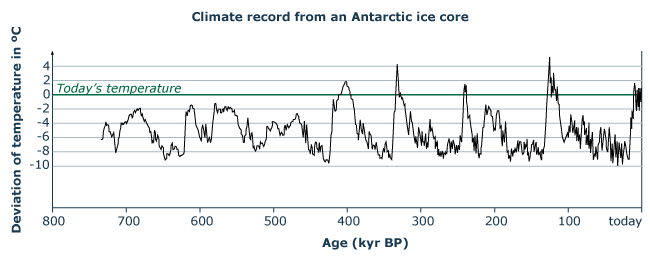 |
|
|
|
|
|
| The Quaternary (a term introduced by A. Morlot in 1858) is a geological period of the Cenozoic and spans, approximately, the last two million years of the Earth's history. The exact duration is a matter of debate; estimated between 1.8 million years and 2.6 million years by different authors. The Tertiary/Quaternary boundary is defined by the Vrica section (1.806 million years BP), a type locality in from Calabria, Italy. The Quaternary is subdivided into the Pleistocene: 2 million years BP to 10 000 years BP, and the Holocene: 10 000 years BP to the present. Note: all ages are given as conventional 14C-years BP; e.g. 10 000 years BP correspond to 11 500 calendar years before present. The Quaternary is a geological period with dramatic and frequent changes in global climate and the period during which much of hominid evolution took place. The overriding controls on the vast variations in climate during the Quaternary are three predominant characteristics of the Earth's astronomical position relative to the sun, which vary cyclically over time on different wavelengthsand cause variations of up to 20% in the total sun-radiation reaching Earth’s surface (Milankovitsch theory). The glacial cycles were strongly driven by the astronomical variables. An Antarctic ice core provides data about climate conditions back to 750 000 years ago. This ice core records eight glacial cycles that have been characterised by long periods (c.100 000 years) of cold climates interspersed with shorter periods (c.10 000 - 28 000 years BP) of warmer conditions. Modern scientific techniques have given us insight into the scale and timing of the climatic changes that, for example, led to the expansion of the global ice caps to three times their present extent, causing glaciation in formerly unglaciated regions. Now, however, the Earth has been entering a time of very rapid changes to a warmer climate, most probably induced significantly by strong human impact. But rapid environmental changes (e.g. in temperature and precipitation) could pose major threats. The thorough reconstruction and understanding of past global changes plays a key role for simulating future climate changes on our planet. |
1 - Data from an Antarctic ice core of temperatures during the last 750 000 years show 8 glacial cycles. For the 4 most recent glacial cycles, the data show a clear warming about every 100 000 years. The earlier period, 750 000 – 430 000 years BP, was characterized by less pronounced warming in interglacial periods (redrawn after EPICA community members, Nature 429, 2004). |
|
EPICA community members, Eight glacial cycles from an Antarctic ice core, 2004, p. 623-628. R. S. Bradley, Quaternary paleoclimatology: methods of paleoclimatic reconstruction, 1985. R. S. Bradley, Paleoclimatology: reconstructing climates of the Quaternary, 1999. H. Liedtke, Eiszeitforschung. Wiss. Buchgesellschaft, 1990. |
|||
29 August 2011 |
||
| |
||
